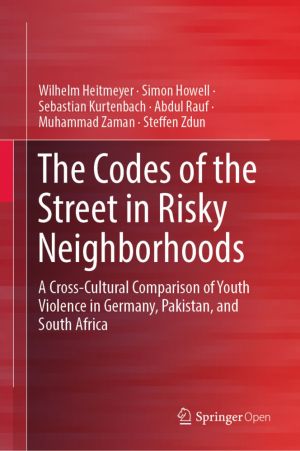The Codes of the Street in Risky Neighborhoods
A Cross-Cultural Comparison of Youth Violence in Germany, Pakistan, and South Africa
by Wilhelm Heitmeyer, Simon Howell, Sebastian Kurtenbach, Abdul Rauf, Muhammad Zaman, Steffen Zdun
DescriptionDetailsHashtagsReport an issue
This volume covers:Research on interpersonal violence.
Thorough review of the contribution of research on gangs, violence, neighborhoods and community.
Analyses on violence-related norms of male juveniles (ages 16-21 years old) living in high-risk urban neighborhoods.
Intense discussion of the concept of street code and its use.
Application of street code concept to contexts outside the US.
An integrating chapter focused on where the street code exists, and how it is modified or interpreted by young men.With a foreword by Jeffrey Ian Ross, this book aims to provide a broader context for research. It does so via a rigorous comparative methodology, presenting a framework that may be applied to future studies. This book will be of interest to researchers in criminology and criminal justice, as well as related fields such as sociology, demography, psychology, and public health. 






Book Description
This book presents a comparative look at the norms and attitudes related to youth violence. It aims to present a perspective outside of the typical Western context, through case studies comparing a developed / Western democracy (Germany), a country with a history of institutionalized violence (South Africa), and an emerging democracy that has experienced heavy terrorism (Pakistan). Building on earlier works, the research presented in this innovative volume provides new insights into the sociocultural context for shaping both young people's tolerance of and involvement in violence, depending on their environment.This volume covers:Research on interpersonal violence.
Thorough review of the contribution of research on gangs, violence, neighborhoods and community.
Analyses on violence-related norms of male juveniles (ages 16-21 years old) living in high-risk urban neighborhoods.
Intense discussion of the concept of street code and its use.
Application of street code concept to contexts outside the US.
An integrating chapter focused on where the street code exists, and how it is modified or interpreted by young men.With a foreword by Jeffrey Ian Ross, this book aims to provide a broader context for research. It does so via a rigorous comparative methodology, presenting a framework that may be applied to future studies. This book will be of interest to researchers in criminology and criminal justice, as well as related fields such as sociology, demography, psychology, and public health.
This open book is licensed under a Creative Commons License (CC BY). You can download The Codes of the Street in Risky Neighborhoods ebook for free in PDF format (2.9 MB).
Book Details
Title
The Codes of the Street in Risky Neighborhoods
Publisher
Springer
Published
2019
Pages
196
Edition
1
Language
English
ISBN13
9783030162863
ISBN10
3030162869
ISBN13 Digital
9783030162870
ISBN10 Digital
3030162877
PDF Size
2.9 MB
License

Related Books

Books about Oxford have generally focused on the University rather than the city. This original book on the local politics of Oxford City from 1830 to 1980 is based on a comprehensive analysis of primary sources and tells the story of the city's progressive politics. The book traces this history from Chartism and electoral reform in the mid-ni...

This book examines the evolution of the relationship between taxpayers and their states in Sweden, Italy, the United Kingdom, the United States, and Romania, and asks why tax compliance is so much higher in some countries than others. The book shows that successful states have built strong administrative capacities, tax citizens fairly and equitabl...

This highly original and timely collection brings together case studies from salient areas of the Himalayan region to explore the politics of language contact. Promoting a linguistically and historically grounded perspective, The Politics of Language Contact in the Himalaya offers nuanced insights into language and its relation to power in this geo...

This open access book explores commentaries on an influential text of pre-Copernican astronomy in Europe. It features essays that take a close look at key intellectuals and how they engaged with the main ideas of this qualitative introduction to geocentric cosmology.
Johannes de Sacrobosco compiled his Tractatus de sphaera during the thirteenth ce...

This book demonstrates the application of simulation modelling and network analysis techniques in the field of Roman studies. It summarizes and discusses the results of a 5-year research project carried out by the editors that aimed to apply spatial dynamical modelling to reconstruct and understand the socio-economic development of the Dutch part o...

This open book adopts a rights-based approach to shed light on the different legal and policy instruments that have been developed to implement circular migration policies in the EU, and their consequences for the rights of migrant workers. It contributes to the understanding of the meaning of this concept in general and in the EU, as well as speci...

